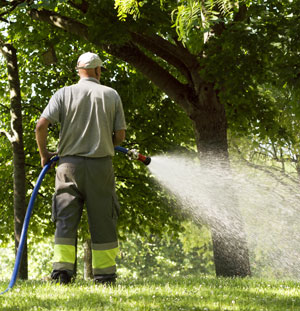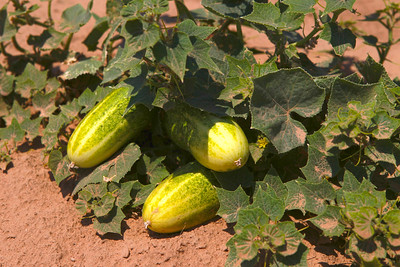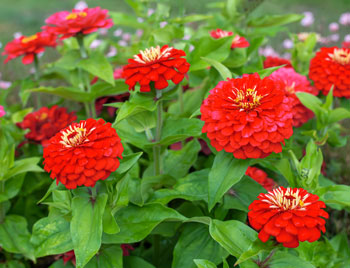Summer Home Landscaping
Summer Gardening Tips
Manage Pests and Diseases
- Scout garden frequently for signs of insects, diseases, and weeds.
- Diseases can spread quickly. Identify any problems you spot by using our Plant Health Clinic Resources or submit a photo and Ask our Pest Crew.
- If you are unsure about what is wrong with your plants, you can also take a plant sample or good pictures and get them to your local county agents. The earlier you identify a problem, the sooner you can get it under control.
Monitor Watering for Trees
How much should you water trees in the summer?

- Plants, trees in particular, exhibit a delayed visual stress symptom. Symptoms include wilt, leaf scorch, or loss of green coloration. Drought stress to many plants, trees especially, could be the beginning of a slow decline and eventual death that cannot be corrected once it occurs.
- To avoid these problems, don’t wait to water until you see these visual symptoms.
- For mature trees, water an inch or more once a week. Newly planted trees require watering twice a week during dry weather.
- Frequency will depend on tree species, soil type and soil internal drainage. Be careful not to overwater. Symptoms of overwatering are the same as not watering often enough.
- For newly planted trees and shrubs, determine moisture needs by using your forefinger as a moisture meter.
- Trees take a beating with high temperatures and lack of rain. If you have a prized tree you want to keep, water twice a week. When you water, water deep. It is better to water more in depth, less often and early in the morning.
- Nutrition gets leached out with frequent watering. If you are growing trees and shrubs, they should do fine with one application of fertilizer per year—usually applied in the spring.
How to water and fertilize shrubs, plants, and turfgrass
- When temperatures are hot, water your plants well before fertilizing, and then water the fertilizer in. Frequent, light applications are best to avoid burning.
- Turf needs about one inch of rainfall or irrigation water per week from May through September. Early morning watering is best for reducing disease buildup. Be sure the lawn is not wet going into the night.
Summertime ornamental plant care
- Summer is the time to dig and divide irises. Irises do best in full sun but will tolerate some shade. High fertility encourages rhizomes to rot and fewer blooms. Fertilize lightly this fall for beds that you dig and divide this summer.
- If your summer annuals look like they are tired, fertilize them with half a pound (one cup) of 34-0-0 per 100 sq. ft. Watering is also important.
- If grass is invading flower beds, use a grass-specific herbicide such as Fusilade/Ornamec
(fluazifop-P), Segment (sethoxydim) or Envoy (clethodim). In our trials fluazifop-P
has been the most effective on bermudagrass. Always read and follow label directions or check with your county agent for specific
advice.
- For all-summer blooming perennials and shrubs, know whether they set seeds or are self-cleaning and drop spent flowers. If your plants are trying to set seeds you will be in the seed business and not the bloom business. Deadhead the spent blooms to direct energy away from seed set and into more blooms.
- Rejuvenate tired annuals by removing faded flowers and cutting back long, leggy stems. Feed with a fertilizer and the plants will be back in bloom in a few weeks.
Summertime vegetable gardening tips

Keep cucumbers well watered! Drought conditions will cause bitter fruit.
- Harvest vegetables regularly to keep them setting fruit.
- Keep plants watered and free of insects.
- Keep pinching back flowering herbs such as basil and oregano in order to prevent them from flowering and going to seed.
- Harvest herbs in early morning hours for peak flavor.
Looking for tips? Explore the vegetable a-z section!
Pruning plants and shrubs in the summer
- In July, prune "bleeder" trees like, maple, dogwood, elm and birch and other trees that "bleed" when pruned in winter.
- Avoid pruning spring-flowering shrubs from now until next spring. Anything you remove now will also be removing next years flowers. Spring-flowering shrubs include azaleas, camellias, witch hazels and rhododendrons among others.
- Prune hydrangea macrophylla as their blooms fade. Cut old flower heads off Hydrangea arborescens such as Annabelle to go a second season, but with a smaller flush of flowers.
- Prune climbing roses and rambler roses after bloom. Remove the older canes a few inches above the graft.
How to prepare your yard and garden for fall

Plant zinnia seeds by July 4th for late bloom in annual border. The tall varieties make excellent
cut flowers for late summer/fall arrangements.
- August is the month to start your fall vegetable garden. Bush beans, cucumbers, summer squash and other short season vegetables can be planted now. Cool season vegetables such as radishes, beets, carrots, lettuce, and others can also be planted at this time. To ensure a good stand of fall crops from seed it’s best to cover rows with burlap, paper, straw or even boards to aid in keeping the soil moist and cool.
- August/September is a good time to get rid of poison ivy and unwanted honeysuckle. Since they are perennials, applying glyphosate (example: Roundup) or triclopyr now can keep them from storing up nutrients for winter and reduce the chance of their surviving until spring. Don’t spray when plants are drought stressed. Wait until 3-4 days after a good rain. Be sure to follow the label directions.
- In July, start planning for a fall garden. Make plantings of squash, tomato, beans, cucumbers, southern peas, pumpkins and any other vegetables which will mature before late October.